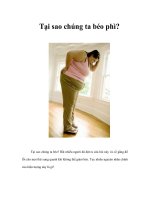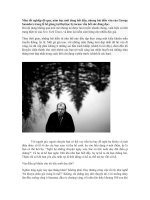Why use bamboo ?(Tai sao chúng ta sử dụng tre)
Bạn đang xem bản rút gọn của tài liệu. Xem và tải ngay bản đầy đủ của tài liệu tại đây (368.86 KB, 5 trang )
WHY USE BAMBOO?
Bamboo is a remarkable and highly versatile natural resource. For many centuries it has been utilised in
Asia in a range of uses, including in cooking, construction, transport, textiles and medicine. It is only
relatively recently that the Western world has discovered how bamboo offers a wide range of benefits
and an eco-friendly solution to many of our modern requirements. Bamboo is, quite simply, a
wonderful, green resource that is hugely beneficial both to the way we want to live our lives and to the
environment.
Sustainable
Eco Friendly
Biodegradable
Bamboo is amazing – it is one
of the fastest growing plants
in the world. Once harvested,
bamboo can replenish itself
within a year and some
species grow a whopping
120cm per day! It is a
naturally prolific and resilient
plant, which does not need
fertilisers to boost its growth,
or pesticides since bamboo is
naturally pestresistant. This
marks it out from cotton or
timber, which needs to be
replanted at every harvest
and requires extensive
spraying and watering to
achieve optimal growth.
Since bamboo requires no
chemicals and very little water to
grow, it is an environmental
wonderplant. As if this were not
enough, bamboo absorbs more
carbon dioxide from the air than
either cotton or timber. It also
releases more oxygen into the
environment which improves air
quality. Cotton farming, on the
other hand, famously requires
extensive irrigation and chemical
spraying a single cotton Tshirt
can use up to 2700 litres of water
in the growing process! Bamboo
is by far the greener option.
Bamboo is 100% natural and
biodegradable which gives
conscientious consumers real
peace of mind. Once you have no
further use for a bamboo product
you can rest easy, knowing that it
will return to the Earth leaving
minimal environmental impact.
Plastic, on the other hand, will
continue to clog up the ecosystem
for the remainder of your lifetime,
your children's lifetime and your
grandchildren's lifetime. So much
better to enjoy a product that has a
small environmental footprint and
leaves barely a trace.
How is bamboo manufactured?
Making Bamboo Fibre
Making Bamboo Hardwood/Ply
Bamboo fibre can be used to make exceptional
modern textiles. Our clothing, such as our
bamboo socks, is made from 100% bamboo
fibre and the fabric is also used in bed linen,
duvet covers towels and much more. Bamboo
can also be blended with cotton, hemp or even
Lycra as required.
Bamboo can also be formed into a construction
material when it is cut and then laminated into
sheets and planks. This clever process entails
cutting stalks of bamboo into thin strips, planing
them flat, then boiling and drying the strips. Finally,
they are then glued, pressed and finished. They
have long been popular in China and Japan and
have only caught on in the West since the mid
1990s. The highest quality bamboo laminate
So, how is it made? In order to produce high
quality bamboo fabric, a process must be used
which uses sodium hydroxide, also known as
caustic soda, to break down the ‘woody’
bamboo. Crushed bamboo is soaked in the
chemical to produce cellulose. There is some
concern that sodium hydroxide is a harmful
chemical, but when used responsibly it has
absolutely no effect on the environment and
workers’ health. It is routinely used in the
processing of organic cotton into fibre and is
approved by the Global Organic Textile
Standards (GOTS) and the Soil Association. It is
also widely used in everything from soap
production to food preparation. Moreover it does
not remain as a residue on bamboo clothing
since it easily washes away.
flooring is exceptionally durable and has even
proven to be up to three times harder than oak, plus
it can look very attractive when used as décor in the
home.
Ultimately, however, manufacturers are
continuing to look into ever greener ways of
producing bamboo fibre in the future. It may not
be a 100% ecofriendly product from start to
finish, but we firmly believe that it is currently the
best choice of material that we can make.
WHAT ARE THE BENEFITS OF BAMBOO IN EVERYDAY
PRODUCTS?
Bamboo has an incredible number of uses – just take a look at our product pages where you will
find bamboo clothing, bamboo sheets and doona covers, bamboo towels and much, much more.
Here are some of the benefits of bamboo throughout your home:
BAMBOO IN CLOTHING
Bamboo is an extremely resilient and durable fibre. At the same time it can feel beautifully soft and
pleasant to the touch. When compared in studies to cotton and polyester, it has been found to be
stronger, have better moisture wicking properties and better moisture absorption than the more
commonplace Western materials. When bamboo fabric is used in clothing it is:
Soft, silky and luxurious to the touch Envelop yourself in
truly unparalleled comfort.
More absorbent than cotton Helps
to wick moisture away from the skin.
Hypoallergenic The ecofriendly bamboo fibres do not
irritate the skin. Gentler than many manmade fibres, bamboo
is a natural solution for those with sensitive skin.
UV protective Protect you and your
loved ones from the sun’s rays in
comfort.
Breathable and thermoregulating Stay comfortable
Biodegradable A greener material
whatever the weather; keeps you cool in summer and warm in that will simply return to the Earth.
winter.
BAMBOO IN THE BEDROOM AND BATHROOM
Use bamboo in the bedroom and enjoy extra soft and durable sheets, pillowcases, duvet covers,
towels and more.
Bedding:
Towels:
Supersoft – Made from 100% bamboo
Marvellous softness 100% bamboo pile
fibre, bamboo sheets are far softer than any
on cotton backing creates a soft towel which is
high thread count cotton sheets.
extremely durable and resistant to piling and
shrinkage.
Highly durable – In our twillwoven
Superabsorbent Our bamboo towels are
bamboo sheets softness comes with builtin
strength.
made of fibres which are four times more absorbent
than cotton towels.
Yearround comfort Bamboo fibre is
Skinfriendly – As they are so absorbent,
thermoregulating, which means our sheets will
keep you warmer in winter and cooler in
there’s no need to rub your skin and cause irritation,
summer.
plus ours only use organic dyes.
Wellfitting – Even after many washes,
or putting them in the drier (not recommended
due to shrinkage), they still fit your bed.
Kind to sensitive skin – Naturally
hypoallergenic, antibacterial, antimicrobial and
more absorbent than cotton making them
excellent against your skin.
BAMBOO IN THE KITCHEN
Bamboo makes highly appealing flooring but its uses in the kitchen stretch far beyond that. It can be
used to create dishes and utensils with real benefits:
Durable – When made to a high standard, bamboo
products can be stronger than aluminum and more
durable than if made of oak.
Flexible – The innate flexibility of bamboo
adds to its strength and versatility.
Biodegradable – More ecofriendly as it
Smooth and cleanly finished – It feels good to the touch will ultimately return to the Earth.
and looks attractive too.
Lightweight – The strength is matches by a superb
lightness which makes it highly practical.
HOW ARE BAMBOO PRODUCTS REGULATED?
All bamboo fibre produced for use in clothing and so on has to be OekoTex 100 certified. OekoTex
is a global certification that allows consumers to easily identify textile products that pose no risk to
human health.
OekoTex 100 certified fibre has been found to contain no trace chemicals that pose any health
threat whatsoever. It is common knowledge that the harmful chemicals can enter the body through
skin contact and during the 1990s it was common practice for some manufacturers to use harmful
substances when making clothing.
And so the globally recognised OekoTex 100 Standard was introduced, giving consumers
reassurance about their choice of textile products. OekoTex® provides the standards and the tests
necessary to screen textiles for substances that include:
cancercausing dyestuffs
formaldehyde
heavy metals
pesticides
preservative ingredients like pentachlorophenol and tetrachlorophenol
synthetic compounds and allergyinducing dyestuffs.
The OekoTex certification also tests for things like pHvalue and colourfastness, which helps to
safeguard consumers' health.
In order to be able to display the OekoTex label on their products and marketing material,
manufacturers have to comply with a range of tests across all stages of production from raw
materials to end products and all the processes in between. The certificate is renewable on a yearly
basis but can be revoked if the manufacturer fails to comply with the OekoTex standards.
How can I be sure that what I am buying is free from harmful chemicals?
Look out for the Oeko “Confidence in Textiles” seal of quality the next time that you make a
purchase. You can rest assured that these products have been manufactured with your wellbeing
in mind.









